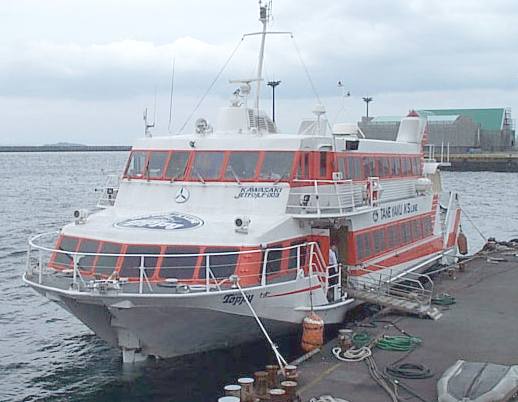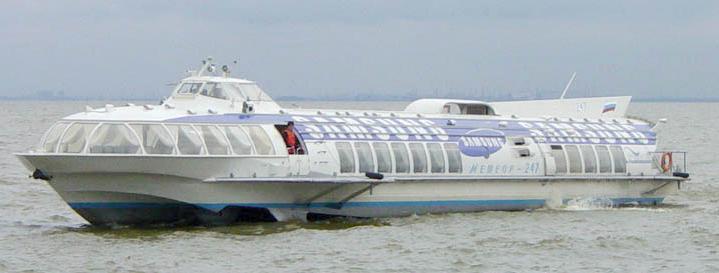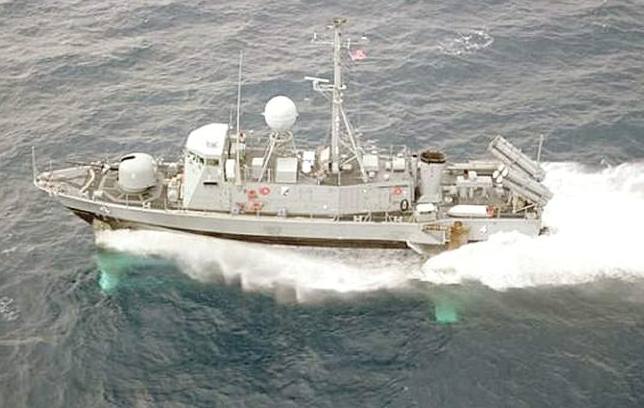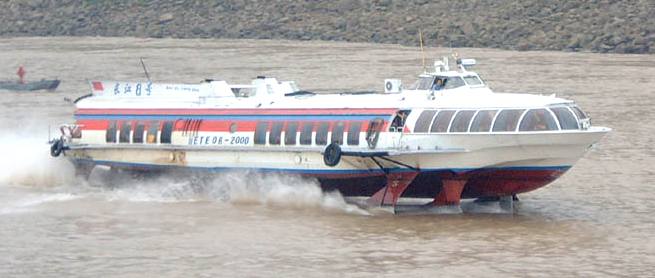|
HYDROFOIL BOATS
|
|
HOME | BIOLOGY | FILMS | GEOGRAPHY | HISTORY | INDEX | MUSIC | THE BOAT | SOLAR BOATS | SPONSORS |
|
A hydrofoil is a boat with wing-like foils mounted on struts below the hull, so as to run underwater. As the craft increases its speed the underwater foils, or hydrofoils, develop enough lift for the boat to become foil-borne - i.e. to raise the hull up and out of the water - literally flying on water. This results in a great reduction in drag and a corresponding increase in speed.
The Jetfoil Toppi is a ferry which connects Yakushima, Tanegashima Island and Kagoshima port in Japan
Early hydrofoils used 'U' or 'V' shaped wings or foils. Hydrofoils of this type are known as surface-piercing since portions of the U-shape hydrofoils will rise above the water surface when foilborne. Modern hydrofoils use T-shape foils which are fully-submerged.
Fully submerged hydrofoils are less subjected to the effects of waves, they are therefore more stable at sea and are more comfortable for the crew and passengers. This type of configuration however is not self-stabilizing. The angle of attack on the hydrofoils needs to be adjusted continuously in accordance to the changing conditions, a control process that is performed by computers. Failure to make the proper adjustments will result in the foilborne hull dropping violently back into the sea.
History
A March 1906 Scientific American article by American hydrofoil pioneer William E. Meacham explained the basic principle of hydrofoils. Alexander Graham Bell considered the invention of the hydroplane a very significant achievement. After reading this article Bell began to sketch concepts of what is now called a hydrofoil boat. With Casey Baldwin he began hydrofoil experimentation in the summer of 1908. Baldwin studied the work of the Italian inventor Enrico Forlanini and began testing models based on his designs. This led him and Bell to the development of hydrofoil watercraft. During Bell's world tour of 1910-1911 he and Baldwin met with Forlanini in Italy. They had rides in the Forlanini hydrofoil boat over Lake Maggiore. Baldwin described it as being as smooth as flying. On returning to Baddeck a number of designs were tried culminating in the HD-4. Using Renault engines a top speed of 87 km/h (54 mph) was achieved, accelerating rapidly, taking wave without difficulty, steering well and showing good stability. Bell's report to the United States Navy permitted him to obtain two 260 kW (350 horsepower) engines. On September 9, 1919 the HD-4 set a world marine speed record of 114 km/h (70.86 mph). This record stood for ten years.
A Meteor floats in displacement mode near Peterhof preparing to travel through the Gulf of Finland to the Winter Palace in St. Petersburg, Russia
Baron von Schertel worked on hydrofoils prior to and during World War II in Germany. After the war Schertel's team was captured by the Russians. Schertel himself went to Switzerland, where he established the Supramar company. In 1952, Supramar launched the first commercial hydrofoil, PT10, in Lake Maggiore, between Switzerland and Italy. The PT10 is of surface-piercing type, it can carry 32 passengers and travel at 35 knots. The Financier Hussain Najadi in 1968 acquired from UBS Group the SUPRAMAR AG of Lucerne, Switzerland. THE COMPANY was the world inventor of Hydrofoils with licensees spanning Europe, USA and Asia. He expanded its operations into Japan, Hong Kong, Singapore, UK, Norway and USA. General Dynamics of the United States became its Licensee and the PENTAGON awarded its first R&D naval research project in the field of super cavitations. Hitachi Shipbuilding of Osaka, Japan, was another Licensee of SUPRAMAR, as well as many leading ship owners and shipyards in the OECD countries. He established over 200 hydrofoil lines spanning five continents. From 1952 to 1971, Supramar designed many models of hydrofoils: PT20, PT50, PT75, PT100 and PT150. Except the PT150, all are of surface-piercing type. Over 200 of Supramar's design were built, most of them by Rodriquez in Italy. Hitachi in Japan had also built some under license.
The Soviet Union experimented extensively with hydrofoils, constructing hydrofoil ferries with streamlined designs, especially during the 1970s and 1980s. Such vessels include the Meteor type and the smaller Voskhod type; these vessels have inspired people in the former Soviet Union to continue tinkering with hydrofoils and selling them to hydrofoil operators.
USS Aquila, a military hydrofoil. The T-shaped foils are visible just below the water
The U.S. Navy operated combat hydrofoils, such as the Pegasus class, from 1977 through 1993. These hydrofoils were fast and well armed, and were capable of sinking all but the largest surface vessels. In their narcotics interdiction role, they were a nightmare for drug runners, being very fast, and having missiles and guns to stop anything they could not catch, as well as the ability to call in air support.
The Italian Navy has used 6 hydrofoils of the Nibbio class from the late 1970s. These were armed with a 76 mm gun, two missiles and were capable of speed up to 50 knots.
Current operation
Some operators of hydrofoil include:
Meteor in China on the Yangtze River, running downstream fast on its hydrofoils
LINKS:
A taste for adventure capitalists
Solar Cola - the healthier cola alternative
This material and any views expressed herein are provided for information purposes only and should not be construed in any way as a prospectus or offer. Please contact the company concerned for information of any business opportunity or specific program. Before investing in any business, you must obtain, read and examine thoroughly its disclosure document or offering memorandum.
|
|
This
website
is Copyright © 1999 & 2006 NJK. The bird |
|
AUTOMOTIVE | BLUEBIRD | ELECTRIC CARS | ELECTRIC CYCLES | SOLAR CARS |



